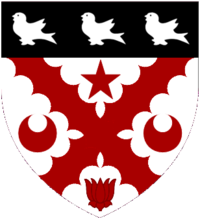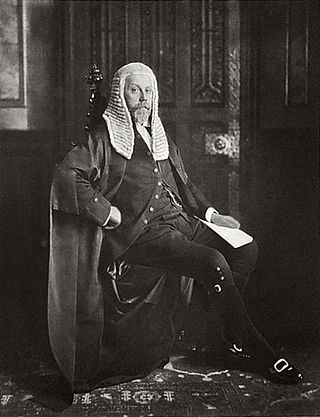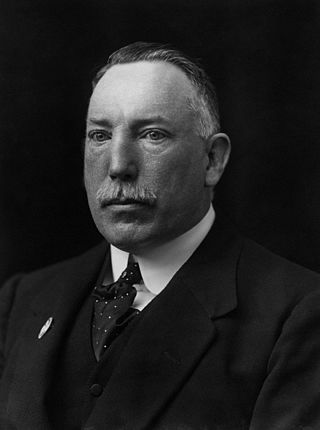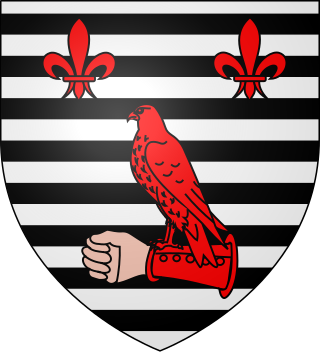Arms
  |
|
Viscount Waverley, of Westdean in the County of Sussex, is a title in the Peerage of the United Kingdom. [1] It was created on 28 January 1952 for the civil servant and politician Sir John Anderson, who served variously as Governor of Bengal, Member of Parliament, Lord Privy Seal, Home Secretary, Lord President of the Council and Chancellor of the Exchequer. As of 2017 [update] the title is held by his grandson, the third Viscount, who succeeded his father in 1990. He is one of the ninety elected hereditary peers that remain in the House of Lords after the passing of the House of Lords Act 1999, and sits as a cross-bencher. [2]
The heir apparent is the present holder's son, the Hon. Forbes Alastair Rupert Anderson (born 1996).
  |
|

Earl Attlee is a title in the Peerage of the United Kingdom. It was created on 16 December 1955 for Clement Attlee, the former Labour prime minister. At the same time he was made Viscount Prestwood, of Walthamstow in the County of Essex, which serves as the subsidiary title to the earldom and is also in the Peerage of the United Kingdom.

Viscount Hailsham, of Hailsham in the County of Sussex, is a title in the Peerage of the United Kingdom. It was created in 1929 for the lawyer and Conservative politician Douglas Hogg, 1st Baron Hailsham, who twice served as Lord High Chancellor of the Great Britain. He had already been created Baron Hailsham, of Hailsham in the County of Sussex, in 1928, also in the Peerage of the United Kingdom. Hogg was the son of the merchant and philanthropist Quintin Hogg, seventh son of Sir James Hogg, 1st Baronet, whose eldest son James McGarel-Hogg, 2nd Baronet was created Baron Magheramorne in the Peerage of the United Kingdom in 1887.

Earl of Rothes is a title in the Peerage of Scotland. It was created in 1458 for George Leslie, 1st Lord Leslie. He had already been created Lord Leslie in 1445, also in the Peerage of Scotland. His grandson, the third Earl, having only succeeded his elder brother in March 1513, was killed at the Battle of Flodden on 9 September of the same year. His son, the fourth Earl, served as an Extraordinary Lord of Session. Lord Rothes was also tried for the murder of Cardinal Beaton but was acquitted.

Viscount of Oxfuird is a title in the Peerage of Scotland. It was created in 1651 for Sir James Makgill, 1st Baronet, along with the subsidiary title of Lord Makgill of Cousland, also in the Peerage of Scotland, with remainder to his "heirs male of tailzie and provision whomsoever". He had already been created a Baronet, of Makgill, in the Baronetage of Nova Scotia on 19 July 1625, with remainder to heirs male whatsoever. The remainder to heirs male whatsoever was a Scottish concept that permitted inheritance by persons not descended from the original grantee, but descended in the male line from male-line ancestors of the grantee. However, on the death of the first Viscount's son, the second Viscount, the Lordship and Viscountcy were assumed by his daughter Christian, as heir of tailzie and provision. Her son Robert Maitland Makgill also voted as Viscount of Oxfuird at the election of Scottish representative peer in 1733.

Viscount Falkland is a title in the Peerage of Scotland. The name refers to the royal burgh of Falkland in Fife.

Earl Russell, of Kingston Russell in the County of Dorset, is a title in the Peerage of the United Kingdom. It was created on 30 July 1861 for the prominent Liberal politician Lord John Russell. He was Home Secretary from 1835 to 1839, Foreign Secretary from 1852 to 1853 and 1859 to 1865 and Prime Minister of the United Kingdom from 1846 to 1852 and 1865 to 1866. At the same time as he was given the earldom of Russell, he was made Viscount Amberley, of Amberley in the County of Gloucester and of Ardsalla in the County of Meath. A member of the prominent Russell family, he was the third son of John Russell, 6th Duke of Bedford.

Earl of Listowel is a title in the Peerage of Ireland. It was created in 1822 for William Hare, 1st Viscount Ennismore and Listowel, who had earlier represented Cork City and Athy in the Irish House of Commons.

Earl Cathcart is a title in the Peerage of the United Kingdom.

Viscount Eccles, of Chute in the County of Wiltshire, England, is a title in the Peerage of the United Kingdom. It was created on 14 January 1964 for the Conservative politician David Eccles, 1st Baron Eccles. He had already been created Baron Eccles, of Chute in the County of Wiltshire, on 1 August 1962. As of 2017 the titles are held by his son, the second Viscount, who succeeded in 1999. He is one of the ninety elected hereditary peers that remain in the House of Lords after the passing of the House of Lords Act 1999, and sits as a Conservative. His wife Diana Eccles was created a life peer as Baroness Eccles of Moulton, of Moulton in the County of North Yorkshire, on 10 May 1990, making the couple an unusual husband and wife pair both sitting in the House of Lords. Lady Eccles of Moulton also sits on the Conservative benches.

Viscount Ullswater, of Campsea Ashe in the County of Suffolk, is a title in the Peerage of the United Kingdom. It was created in 1921 for James Lowther upon his retirement as Speaker of the House of Commons. He was the eldest son of the Hon. William Lowther, third son of the Hon. Henry Lowther, second son of William Lowther, 1st Earl of Lonsdale. The first Viscount lived to the age of 93, and was pre-deceased by both his eldest son the Hon. Christopher Lowther, a Conservative politician, and his eldest son's eldest son John Arthur Lowther (1910–1942), the title being inherited by his seven-year-old great-grandson, the second and current Viscount, in an extremely rare instance of a great-grandson succeeding his great-grandfather in a peerage. The second Viscount held office in the Conservative administrations of Margaret Thatcher and John Major and since 2003 he has been one of the ninety elected hereditary peers that remain in the House of Lords after the passing of the House of Lords Act 1999.

Viscount Trenchard, of Wolfeton in the County of Dorset, is a title in the Peerage of the United Kingdom. It was created in 1936 for Marshal of the Royal Air Force, Hugh Trenchard, 1st Baron Trenchard. He had already been created a Baronet, of Wolfeton in the County of Dorset, in the Baronetage of the United Kingdom in 1919 and Baron Trenchard, of Wolfeton in the County of Dorset, in 1930, also in the Peerage of the United Kingdom. His second son, the second Viscount, held junior ministerial positions from 1979 to 1983 in the Conservative administration of Margaret Thatcher. As of 2018 the titles are held by the latter's son, the third Viscount, who succeeded in 1987. In 2004 he replaced the recently deceased Lord Vivian as one of the ninety elected hereditary peers that are allowed to remain in the House of Lords after the passing of the House of Lords Act 1999. Lord Trenchard sits on the Conservative benches.

Viscount Thurso, of Ulbster in the County of Caithness, is a title in the Peerage of the United Kingdom. It was created on 11 June 1952 for the Scottish Liberal politician and former Secretary of State for Air, Sir Archibald Sinclair, 4th Baronet. His son, the second Viscount, served as Lord Lieutenant of Caithness from 1973 to 1995.

Viscount Astor, of Hever Castle in the County of Kent, is a title in the Peerage of the United Kingdom. It was created in 1917 for the financier and statesman William Waldorf Astor, 1st Baron Astor. He had already been created Baron Astor, of Hever Castle in the County of Kent, in 1916, also in the Peerage of the United Kingdom.

Viscount Bridgeman, of Leigh in the County of Shropshire, is a title in the Peerage of the United Kingdom. It was created in 1929 for the Conservative politician William Bridgeman, who had previously served as Home Secretary and First Lord of the Admiralty. He was the son of Reverend John Robert Orlando Bridgeman, third son of George Bridgeman, 2nd Earl of Bradford. His son, the second Viscount, served as Lord Lieutenant of Shropshire from 1951 to 1969. As of 2014 the title is held by the latter's nephew, the third Viscount, who succeeded in 1982. He is one of the ninety elected hereditary peers that remain in the House of Lords after the passing of the House of Lords Act 1999, and sits as a Conservative.

Viscount Craigavon, of Stormont in the County of Down, is a title in the Peerage of the United Kingdom. It was created in 1927 for Sir James Craig, 1st Baronet, the Prime Minister of Northern Ireland. He had already been created a baronet, 'of Craigavon, in the County of Down' in 1918. As of 2017, the titles are held by his grandson, the third Viscount, who succeeded his father in 1974. He is one of the ninety elected hereditary peers that remain in the House of Lords after the passing of the House of Lords Act 1999, and sits as a crossbencher.
Viscount Camrose, of Hackwood Park in the County of Hampshire, is a title in the Peerage of the United Kingdom. It was created on 20 January 1941 for the prominent newspaper magnate William Berry, 1st Baron Camrose. He had previously received the award of Baronet, of Long Cross in the County of Surrey, in the Baronetage of the United Kingdom, on 4 July 1921, and was created Baron Camrose, of Long Cross in the County of Surrey, on 19 June 1929, in the Peerage of the United Kingdom. His second son, the third Viscount, disclaimed the peerages in 1995 on succeeding his elder brother. However, he had already been created a life peer as Baron Hartwell, of Peterborough Court in the City of London, on 19 January 1968. On his death in 2001 the life peerage became extinct while he was succeeded in the other titles by his eldest son, the fourth Viscount. The first three Viscounts all headed The Daily Telegraph at one point, the first having purchased it from Harry Levy-Lawson, 1st Viscount Burnham, but in the 1980s they lost control to Conrad Black.

Baron Astor of Hever, of Hever Castle in the County of Kent, is a title in the Peerage of the United Kingdom. It was created in 1956 for John Jacob Astor, a prominent newspaper proprietor and Conservative politician. He was the fourth child of William Waldorf Astor, 1st Viscount Astor. Lord Astor of Hever was succeeded in 1971 by his eldest son, the second Baron, who served as Lord Lieutenant of Kent between 1972 and 1982.
Baron Moran, of Manton in the County of Wiltshire, is a title in the peerage of the United Kingdom. It was created on 8 March 1943 for the physician Charles Wilson. He is chiefly remembered as Winston Churchill's personal physician during the Second World War and was president of the Royal College of Physicians from 1941 to 1949. His diary of his association with Churchill—that continued to Winston's death in 1965—was published in 1966.

John Desmond Forbes Anderson, 3rd Viscount Waverley, is a British hereditary peer.
David Alastair Pearson Anderson, 2nd Viscount Waverley, was a British hereditary peer and physician. He trained as a physician in Germany and England, served in the Royal Air Force during the Second World War, and then specialised as a cardiologist. Having succeeded his father as Viscount Waverley in 1958, he also sat in the House of Lords where he regularly spoke on health matters and other interests of his.